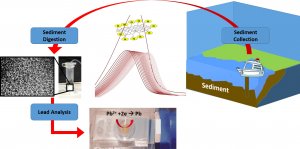
Mr. James J. Tuchi has made a substantial donation to health-research initiatives at Rutgers University. A portion of which will go to helping CAIT continue to develop its MEMS sensor for detecting lead in water and sediments. Photo ©Rutgers Foundation.
Grateful for the excellent medical care he received from Rutgers University physician, distinguished professor, and CAIT-affiliated researcher, Clifton R. Lacy, M.D., a New Jersey business leader has pledged an $8 million donation to fund multiple innovative public health projects at Rutgers. Among these donations, $250,000 is directed to CAIT’s MEMS sensor research, a project developing a new, portable technology that can rapidly measure trace levels of lead in sediment, water, and environmental and biological samples.
President, CEO, and founder of Millennium Healthcare Solutions, Mr. James Tuchi is donating $8 million in support of health-research initiatives at Rutgers as a grateful patient gift.
As a result of receiving life-saving cardiac care from doctors at the Rutgers Robert Wood Johnson Medical School (RWJMS) decades ago and since that time, Mr. Tuchi was grateful and took interest in research at Rutgers and what he could do to help.
Then, and since that time, Mr. Tuchi has been under the care of Cardiologist Clifton R. Lacy, M.D., former chief of cardiology at RWJMS and currently a CAIT-affiliated researcher and distinguished professor at the School of Communication and Information. Dr. Lacy worked closely with Mr. Tuchi to identify interdisciplinary projects ranging from trauma training to biohazard response to crisis communication that could benefit from the gift.
Dr. Lacy noted that the gift will promote “the acceleration of discovery, innovation, and development right here at Rutgers,” and said that Mr. Tuchi’s generosity will have “a multiplier effect for a long time to come.”
Among the projects to be funded is research at the Rutgers Center for Advanced Infrastructure and Transportation (CAIT) to develop a portable sensor for detecting lead in environmental and biological samples. The CAIT team will receive $250,000 to continue developing the technology.
The CAIT team has created a device that can measure small amounts of lead in sediments and waterways within minutes. This is far faster than current laboratory tests that can take days, and could allow municipalities, water companies, universities, schools, daycares, and homeowners to more easily test their water supplies in the future.
“Detecting toxic metals like lead, mercury and copper normally requires collecting samples and sending them to a lab for costly analysis, with results returned in days,” said CAIT-affiliated researcher and associate professor in the Department of Electrical and Computer Engineering
Dr. Mehdi Javanmard. “Our goal was to bypass this process and build a sensitive, inexpensive device that can easily be carried around and analyze samples on-site within minutes to rapidly identify hot spots of contamination.”
The research focused initially on analyzing lead in sediment samples as many river sediments in New Jersey and nationwide are contaminated by industrial and other waste dumped decades ago. Proper management of contaminated dredged materials from navigational channels is important to limit potential impacts on wildlife, agriculture, plants, and food supplies.
The device works by extracting lead from a sediment sample and purifying it, with a thin film of graphene oxide as a lead detector.
The CAIT team also includes Dr. Ali Maher, CAIT director and a professor in the Department of Environmental and Civil Engineering; Dr. Robert Miskewitz, an associate research professor in the Department of Environmental Sciences in the School of Environmental and Biological Sciences; and Dr. Kelly Francisco, a postdoctoral research associate at CAIT.

Sediments collected by a ship can be rapidly tested for toxic lead with a new portable lab-on-a-chip device. The miniature device extracts lead from a sample and purifies it, using graphene oxide as a lead detector. Photo ©Azam Gholizadeh/Rutgers Today.
The technology stems from a USDOT University Transportation Center research project, “MEMS Sensor Development for In-Situ Quantification of Toxic Metals in Sediment,” that was designed to build a portable micro-electro-mechanical systems (MEMS) probe that could rapidly determine locations of metal contamination in sediments and improve sediment management practices.
“The quick identification of contaminated areas and waterways made possible with this technology can help us to push sediment management state of the art forward, and also has potential for other applications in the public health and medical fields,” said Dr. Maher. “This project shows the value of UTC research at Rutgers, and we are grateful for the generous gift from Mr. Tuchi that will go a long way in amplifying these efforts.”
To further develop this tool in the medical and public health space, CAIT has been working in collaboration with Dr. Lacy who is also a senior research scientist at the Center. His focus has been on identification of the medical and public health uses for such a device.
Exposure to lead and lead poisoning can have serious health impacts and can severely affect mental and physical development, which puts young children especially at-risk. The Flint Water Crisis and Newark Water Crisis are just two recent examples of elevated levels of lead being found in water.
Dr. Lacy said that this tool can benefit public health by providing a portable solution that can be brought into communities, and into the home and point-of-care to provide rapid-result lead testing. The efficiency, ease of use, and low cost associated with the device are features that will promote testing.
Currently, researchers are refining the prototype bench-top model in advance of producing a portable version.

